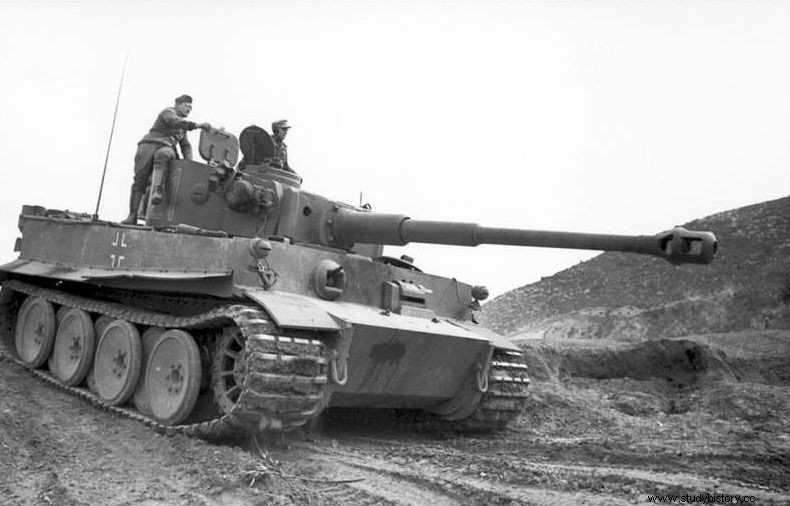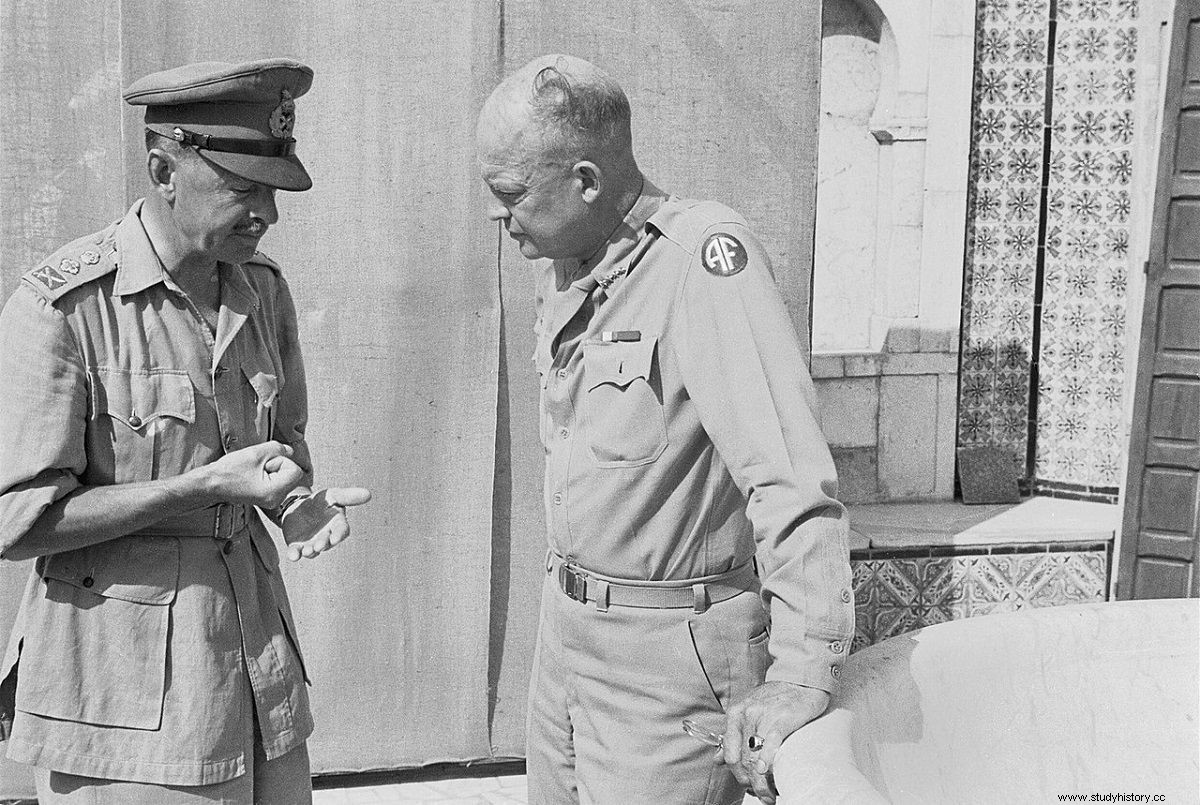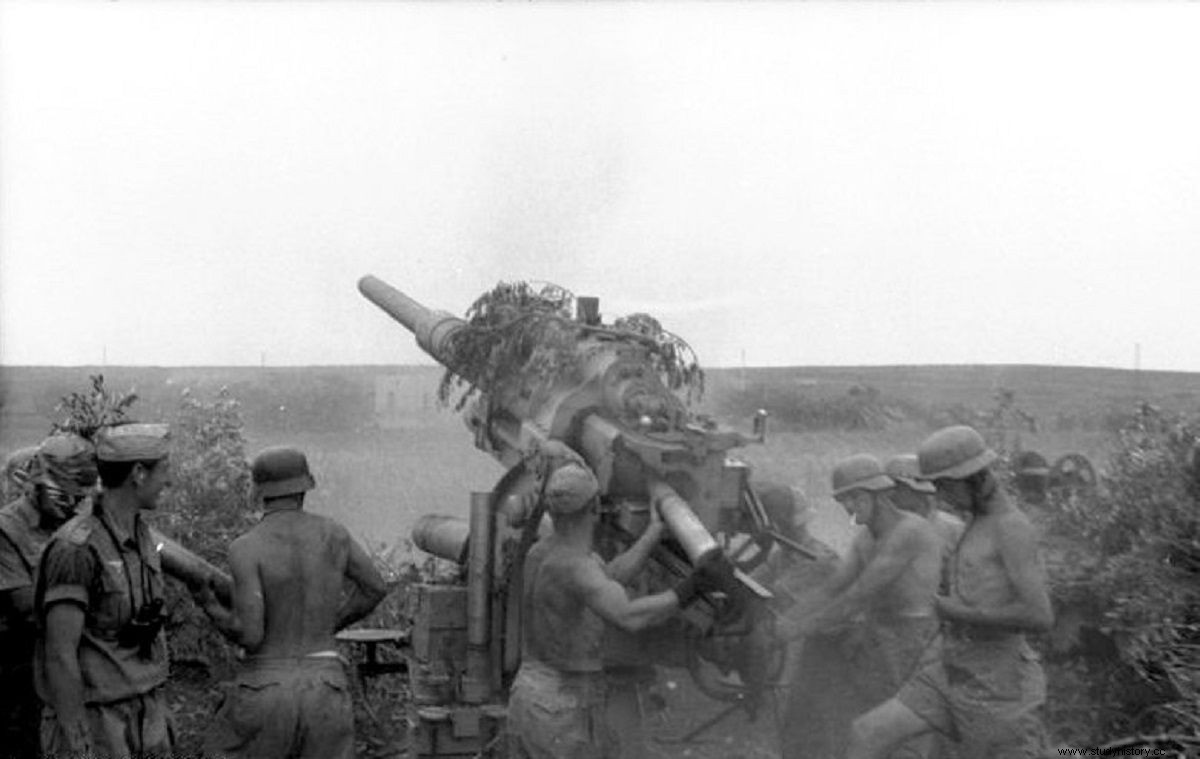
On February 27, 1943, the US 1st Infantry Division , with Terry de la Mesa Allen Sr. in command, he left the front line to rest for ten days at Marsott, northwest of Tébessa, where he assembled all his elements for the first time in the campaign. As Allen's forces moved into the town of Gafsa, the move was part of a new limited offensive, ordered by General Sir Harold Alexander , commander of the 18th Army Group, formed on 20 February to streamline coordination between the US First Army and the British Eighth Army. II Corps was to advance on Gafsa , secure it and establish a supply depot there, thus securing Montgomery's left flank while his Eighth Army attempted to break through the Mareth Line and advance across the coastal plain. Patton ordered Allen to advance on Gafsa on March 17. Gafsa's Italian and German defenders withdrew without further ado, leaving Allen to take the town without a shot being fired. The unexpected speed of II Corps success, coupled with the imminent launch of Operation Pugilist (scheduled for March 19), gave Patton another chance to put his forces into action. 
The plan called for a advance in two axes . The first, centered on Ward's 1st Armored Division, would seize Sened Station and then continue on to Maknassy. The second would see Allen's 1st Infantry Division and supporting elements move east along the Gafsa-Gabès highway through El Guettar , a town captured on March 18 by Lt. Col. William O. Darby's 1st Ranger Battalion, and to the plains beyond.
Darby's Rangers acted as the vanguard of Allen's division . Setting out on the afternoon of 20 March, the 500 men of the 1st Ranger Battalion and a 70-strong supporting mortar unit advanced along the Gafsa-Gabès road before making their way through the mountainous terrain to the north of the route. As dawn broke on March 21, they appeared on high ground overlooking the main Italian position defending Gumtree Road, upon which they launched a surprise attack that defeated the enemy and bagged more than 1000 prisoners. Allen now moved through El Guettar and into the hills to the east, flanking the Gumtree and Gafsa-Gabès roads. That same day Sened Station fell to Ward's forces, though his advance was slowed by muddy roads.
The 10th Panzer Division in El Guettar
Determined to neutralize the threat posed by the American battlegroups, the Generaloberst Hans-Jürgen von Arnim ordered the 10th Panzer Division to intercept and push back the II Corps advance at Maknassy and El Guettar. But, forewarned of a possible German attack by intelligence reports, Allen halted his advance and planted his division in the wide basin of the valley about 13 kilometers east of the town of El Guettar. Allen's assets included:
- 16th Infantry Regiment (Colonel d'Alary Fechet), with only the 1st Battalion; the 2nd was held in reserve at El Guettar and the 3rd garrisoned Gafsa.
- 18th Infantry Regiment (Colonel Frank U. Greer).
- 26th Infantry Regiment (Colonel Alexander N. Stark).
- 1st Ranger Battalion (Lieutenant Colonel William O. Darby).
- 601st Tank Destroyer Battalion, equipped with 31 GMC M3s and 5 M6s (Lieutenant Colonel Herschel D. Baker).
- Company A
- Company B (Capt. Henry E. Mitchell).
- Company C (Capt. Herbert E. Sundstrom).
- Reconnaissance Company (Capt. Michael Paulick).
- 899th Tank Destroyer Battalion, equipped with M10 GMCs and in reserve at Gafsa (Lt. Col. Maxwell A. Tincher).
- 2nd (105mm), 5th (155mm; Maj. Robert N. Tyson), and 22nd (105mm; Lt. Col. Percy W. Thompson) battalions of the 17th Field Artillery Regiment.
The 26th Foot Regiment was positioned on Gumtree Road, north of Hill 621, protecting the left flank. The 1st Battalion, 16th Infantry Regiment was deployed in the center, along with the 3rd Battalion, 18th Infantry Regiment along the El Keddab Ridge, a rise of rugged terrain that ran approximately north south across the valley floor, and which had a ridge of high ground towards its southern edge that overlooked the road, Hill 336. The remaining two battalions of this latter regiment had been assigned to the rugged heights of Djebel Berda , across the road to the south. The companies of the 601st Tank Destroyer Battalion were positioned north of the Gafsa-Gabès road, with Company A being situated on a slope that commanded the northern edge of the road and Companies B and C opposite the divisional artillery positions, that were south of Djebel El Ank.
On the night of March 22, the 10th Panzer Division race from the coast had brought them to within 10 miles of the US positions at El Guettar. Led by the Generalmajor Friedrich Freiherr von Broich and with about 6,000 men, the Kampfgruppe of the division consisted of:
- 7th Panzer Regiment (Oberst Rudolf Gerhardt), with two battalions and about 50 Panzer III and IV.
- 2nd Battalion of the 69th Panzergrenadier Regiment (Major Paul Pomée).
- Command Company (Oberst Hans Reimann) and 2nd Battalion of the 86th Panzergrenadier Regiment (Hauptmann Wilhelm Leyendecker).
- 10th Motorcycle Battalion (Major Dr. Heinrich Drewes).
- 49th Panzer Engineer Battalion (Major Albert Krumsiek).
- A company of the 90th Panzerjäger Battalion , equivalent to seven StuG III.
- 3rd (Major Alfred von Rosenberg-Lipinsky) and 4th Battalion (Anti-Aircraft, Major Dr Mounted) of the 90th Panzer Artillery Regiment .
- A detachment from the 131st Centaur Armored Division.
The rest of the division was grouped into the Kampfgruppe Lang and would fight to the north , at the Maknassy Pass.
Although initially advancing en masse, the Kampfgruppe German would eventually deploy into three Angriffsgruppen . A column, composed of the 2nd Battalion of the 69th Panzergrenadier Regiment and Panzer , would move to the north, in the direction of Djebel El Ank; the 10th Motorcycle Battalion would turn southwest towards Djebel Berda and Chott El Guettar; the remaining force, which included most of the panzers as well as the 2nd Battalion of the 86th Panzergrenadier Regiment , it would head straight for the heart of the American line, orbiting around Hill 336 and the El Keddab ridge.
At 0300 hours on March 23 the Germans started their engines and headed west , towards Allen's position. 1st Lieutenant Joseph A. Gioia, leader of a reconnaissance platoon of the 601st Tank Destroyer Battalion, saw the silhouettes of infantry between 0430 and 0445 hours and heard the rumble of German tanks. At the same time, two men on a motorcycle with a sidecar appeared to the right of his position; In a matter of seconds, the American fire wounded one of the Germans and the other, capable of being interrogated since both were captured by Gioia's men, reported that the attack would take place around 5:00. This was quickly relayed to Allen's headquarters, and the 601st readied itself in the few minutes it had left. Between 0510 and 0530 hours, 2nd Platoon (1st Lt. Robert A. Luthi) of Mitchell Company B was the first to fight the Germans (more than 10 tanks and 2 infantry companies).
The attack on the American center was carried out by the strongest German units , and was aimed at the most difficult section of the 1st Infantry Division's perimeter to defend:the base of the valley. Being more or less flat, it provided little cover for an attacker or defender, with the only major terrain feature being the El Keddab ridge line. The pivot of the American position was Hill 336, where Colonel Greer had established the command post of the 18th Infantry Regiment. Spread out in trenches and pits, the infantry of the 3rd Battalion, 18th Regiment (minus Company K, based on Hill 482) positioned themselves on the eastern approach to Hill 336. German artillery opened fire around 0730 hours on Greer's infantry. The German advance was covered by huge smoke screens generated by the panzers, blocking their identification until they got too close. Forced to retreat under the intensity of the attack , both the 18th Regiment's 3rd Battalion and the 16th Regiment itself hurried back towards the El Keddab ridge; there, they stopped at a wadi, regrouped, and then worked their way back until they regained their positions. The other impulse of the Angriffsgruppen The center line was directed at the gun line of the 5th and 32nd Field Artillery Battalions, which were exposed in the process of repositioning the division. American guns fired salvos over open sights and at point-blank range, but it was not enough. After disabling the weapons, the crews abandoned them and withdrew. Each battalion lost six guns.

The 601st GMC M3s weren't either having a good time The German vanguard consisted of twenty-two panzers of various types, which advanced head-on into the gap that cut the road across the El Keddab ridge. There was limited room for the Germans to maneuver as Chott El Guettar made the terrain south of the road impenetrable, which helped corner the panzers and keep them within range of the 75mm guns> of the 601st. The battalion threw everything they had at the attackers, forcing the panzers to turn on patches of soft ground and bogging down some. In an effort to avoid the 601st's artillery, other panzers swerved into a well-placed minefield, which combined with this brought the German advance to a standstill around 0820 hours. Around 0950 hours the 899th Tank Destroyer Battalion would arrive as reinforcement to the 601st, with companies B and C in front and A in reserve.
The half-tracks of the German northern force reached the base of Djebel el Mcheltat (Hill 482) just as dawn was breaking. Pomée singled out two Panzergrenadier companies supported by a handful of panzers to reach the top of Hill 482. For their part, the defenders of the hill were doing their best to keep the Germans at bay. Infantry from Company K of the 18th Regiment of Foot (Capt. Clifford B. Raymer) were assigned to hold the hill for the night, where he had his men dig in and put together some simple defenses to the best of their ability. The Germans attacked hard and fast down the lower slopes of the hill, but the following ones, together with the rugged nature of the terrain, made further mechanized progress impossible, forcing the men to dismount from the vehicles and climb the slope on foot. As the Panzergrenadier As they advanced, they were showered with bullets and hand grenades from the hillsides above them. Even their vehicles came under attack, losing at least three half-tracks and a Panzer II . The Panzergrenadiers They came within 50m of the ridge, but the fighting led to an exchange of bullets and hand grenades that lasted for the rest of the morning.
The 10th Motorcycle Battalion's advance into Djebel Berda proved similarly unsuccessful, encountering terrain in which it was impossible to manoeuvre , even for your light vehicles. They carried out some probing attacks, but found no weak points that they could quickly exploit, and retreated towards Djebel Kreroua, awaiting developments.
Denouement in El Guettar
For the rest of the morning, both sides lowered their intensity and dedicated themselves to rebuilding their ranks. At 1325 hours, the 1st Ranger Battalion observation post reported that German tanks were 18 km east of El Guettar and they were retreating further east. At 1518 hours Allen was informed by radio intercept that the 10th Panzer Division would attack again at 4:00 p.m. with the 1st and 2nd battalions of the 86th Panzergrenadier Regiment , 1st and 2nd battalions of the 7th Panzer Regiment and the 2nd and 4th Battalions of the 90th Panzer Artillery Regiment . At that point, the 16th Infantry Regiment was ordered to hand over the defense of Gafsa to the 39th Regiment and to move the rest of its forces to the vicinity of El Guettar.
The second German assault began at 4:45 p.m., and ten minutes later Allen was informed that they were advancing down the valley. At 5:10 p.m. the attack reached its zenith , once again against the positions of the 3rd Battalion of the 18th Infantry Regiment, which came to be surrounded. Greer's soldiers held their positions despite German attacks which, poorly supported by armor and mounting casualties from artillery bombardment, began to fall back. By 5:40 p.m., it was clear to Broich that further pressure would be little more than suicide. Exhausted and battered, the 10th Panzer Division retired out of range allied gunner to lick his wounds. The 1st Infantry Division had stopped it in its tracks.
Bibliography
- Barron, Leo (2018). Showdown at Death Valley . Historynet.com.
- Butler, Allen S. (1949). The Operations of the First Infantry Division at El Guettar, 20–30 March, Tunisian Campaign . Fort Benning, GA:The Infantry School.
- Campbell, David (2019). US Soldier vs Afrikakorps Soldier . Osprey Publishing.
- Hackett, Paul T. (1950). "The Operations of the 1st Infantry Division at El Guettar, 20–24 March 1943 (Tunisian Campaign)". Fort Benning, GA:The Infantry School.
- Howe, George F. (1957). Northwest Africa:Seizing the Initiative in the West . Washington, DC:Center of Military History, US Army.
- Miskimon, Christopher (2016). American Tank Destroyers at El Guettar – The U.S. 601st Tank Destroyer Battalion faced down the German 10th Panzer Division in the hills east of the Tunisian town . Warfare History Network.
- Rolf, David (2001). The Bloody Road to Tunis:Destruction of the Axis Forces in North Africa, November 1942–May 1943 . London:Greenhill. Pages.181-182.
- Failmezger, Victor (2015). "Chapter 3 – Vindication in North Africa". American Knights:The Untold Story of the Men of the Legendary 601st Tank Destroyer Battalion . Osprey Publishing.
